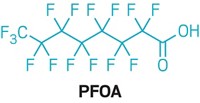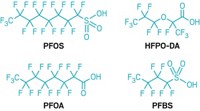Advertisement
Grab your lab coat. Let's get started
Welcome!
Welcome!
Create an account below to get 6 C&EN articles per month, receive newsletters and more - all free.
It seems this is your first time logging in online. Please enter the following information to continue.
As an ACS member you automatically get access to this site. All we need is few more details to create your reading experience.
Not you? Sign in with a different account.
Not you? Sign in with a different account.
ERROR 1
ERROR 1
ERROR 2
ERROR 2
ERROR 2
ERROR 2
ERROR 2
Password and Confirm password must match.
If you have an ACS member number, please enter it here so we can link this account to your membership. (optional)
ERROR 2
ACS values your privacy. By submitting your information, you are gaining access to C&EN and subscribing to our weekly newsletter. We use the information you provide to make your reading experience better, and we will never sell your data to third party members.
Persistent Pollutants
Why limiting PFAS in drinking water is a challenge in the US
The EPA faces legal and other hurdles as it attempts to regulate PFOA and PFOS
by Cheryl Hogue
July 13, 2020
| A version of this story appeared in
Volume 98, Issue 27

An article in the local newspaper caught Andrea Amico’s eye in May 2014. It reported that one of the three drinking-water wells at a sprawling business and industrial park nearby was shut down because of high levels of chemical contamination.
“Instantly, my heart sank,” says the Portsmouth, New Hampshire, woman. Amico recalls her reaction to the news: “My husband works there and he drinks water all day, and my two kids go to daycare there and they drink water all day.”
She’d never heard of the substances tainting the tap water—Portsmouth was one of the first communities in the US to discover these chemicals in public drinking water. Amico, who holds a master’s degree in occupational therapy and works in health care, started researching health effects from these contaminants and at first found little information.
Today, the situation has changed.
Amico now knows the identity of the chemicals found at the facility, the Pease Tradeport, built on the site of the former Pease Air Force Base after it closed in 1991. She confidently tosses out the term “per- and polyfluoroalkyl substances” (PFAS), which describes this class of compounds. She easily describes the strong carbon-fluorine bonds the chemical industry forges in manufacturing PFAS to create products that are durable under harsh conditions. She explains that these bonds mean PFAS don’t break down easily in the environment, earning them the nickname “forever chemicals.” She understands that the PFAS in the Tradeport tap water likely stemmed from firefighting foam used at the air base. She is up-to-date on studies describing the potential health effects from these substances.
And she knows that the blood of her husband and two children who attended the Tradeport daycare tested high for PFAS. In 2015 Amico and two other women founded a community activist group that helped secure those blood tests and was instrumental in getting a federal health study of PFAS-exposed people.
That investigation just started, so Amico doesn’t know what the PFAS levels in her family’s blood might portend for their health.
Meanwhile, Amico’s group has joined others across the US calling for the federal Environmental Protection Agency to limit the amount of all PFAS collectively in drinking water to 1 part per trillion (ppt). There are approximately 5,000 known PFAS. The EPA currently has a nonbinding advisory recommendation of 70 ppt for just 2 of the substances, perfluorooctanoic acid (PFOA) and perfluorooctanesulfonic acid (PFOS), individually and combined.
To set an enforceable limit, the EPA must pass through a complex set of steps established in law to regulate contaminants in drinking water. And powerful lobbies that face cleanup liability, including the chemical industry, oppose regulation of PFAS as a group.
PATH TO REGULATION
Here are the steps that the EPA must go through before it can limit the amount of a chemical or other contaminant allowed in public drinking water.

The EPA places a chemical—or a microbe such as a virus or bacterium—on a list of candidates for regulation. The agency can add new candidates to the list every 5 years. The chemicals shown were added to the list in 2009.

The EPA issues a rule requiring large, public drinking-water utilities to monitor for the contaminants on the list. The agency conducts or pays for similar monitoring for some smaller systems.

The EPA analyzes the monitoring data

The EPA must study at least five contaminants on the list and decide whether any need regulating. To determine this, the contaminant must meet three criteria. First, the agency administrator must conclude that a contaminant may have an adverse effect on public health. Second, the contaminant must be likely to occur in public drinking water “with a frequency and at levels of public health concern”—a phrase that Congress did not define. Third, the administrator must decide that regulation “presents a meaningful opportunity” to reduce health risks for people served by public water utilities. The agency must issue a proposal to regulate or not regulate a contaminant, consider public comment, and then finalize its decision whether to regulate. If the agency decides not to regulate, the process stops here.

The agency next must assess health risks, weigh the costs and benefits of a regulation, determine what water treatment technologies are available to large systems, and identify technology that small systems can afford.

The EPA proposes a standard to limit the contaminant in public drinking water and accepts public comments on the plan.

The EPA revises the proposal in light of comments then finalizes it as an enforce- able regulation. The agency can set a limit for a contaminant that is weaker than technology can deliver if the agency determines that health benefits won’t justify the cost of treatment.
Note: The Safe Drinking Water Act allows the EPA to set a limit on a drinking water contaminant in urgent situations threatening public health. However, the agency would have to reevaluate that standard within 3 years. The agency also has the authority to control a contaminant not listed as a candidate for regulation if the EPA can meet the criteria in step 4.
Long time coming
The question of whether and how much to regulate these persistent chemicals in drinking water has spanned the administrations of US presidents George W. Bush, Barack Obama, and Donald J. Trump. “This is a multi-administration failure to take action on PFOA and PFOS and on the broader class of PFAS chemicals that may pose health effects,” says Melanie Benesh, legislative attorney for the Environmental Working Group, which has called for limiting the two chemicals in drinking water since the early 2000s. “It has taken EPA an extraordinarily long time to do anything.”

Action toward possibly regulating these chemicals in drinking water began about a decade ago, when the EPA gathered data collected by water utilities on occurrence and levels of PFOA and PFOS. Neither PFOA nor PFOS is manufactured domestically anymore, but communities across the nation face legacy pollution. Also, either chemical may still be imported as a component, such as a coating, in products.
Drinking water in at least 25 states is tainted with PFOA or PFOS. In some areas, including the Pease Tradeport, other PFAS also turn up, according to data gathered by the Environmental Working Group and Northeastern University. Overall, PFAS may contaminate public drinking-water systems that serve an estimated 19 million people living in the US.
PFOA and PFOS are the best studied of all PFAS. Each can cause harmful effects to reproduction and development as well as to the liver, kidney, and immune system in laboratory animals, the EPA says. In addition, limited evidence shows PFOA exposure is associated with cancer and PFOS exposure is associated with thyroid hormone disruption, according to the EPA.
Last year, as part of its PFAS action plan, the Trump administration pledged to make a formal decision, called a regulatory determination, on whether PFOA and PFOS need to be controlled as drinking-water contaminants. An affirmative decision would lead to about 4 more years of legally required steps before the EPA can finalize a regulatory limit.
Such limits are called maximum contaminant levels. The EPA has them for about 90 contaminants. But other than individual pollutants that Congress has specifically ordered the EPA to regulate, the agency hasn’t set limits on any additional pollutants since lawmakers revised the Safe Drinking Water Act in 1996.
The previous version of the Safe Drinking Water Act, enacted in 1985, required the EPA to regulate 25 new or emerging contaminants every 2 years, says Erik Olson, who directs advocacy initiatives on health, food, and agriculture at the Natural Resources Defense Council, an environmental advocacy group. The 1996 amendments abolished those numerical requirements and replaced them with analytical requirements that Olson describes as burdensome. “The Safe Drinking Water Act is broken,” he says.
Michael H. Shapiro, who retired in 2017 as the EPA’s acting water chief after 35 years at the agency, says that under the current process, the agency must pay close attention to science, costs, and benefits when setting drinking-water standards. That creates a lot of work for the EPA to determine that a contaminant poses possible harm to public health and how it should be controlled. Consequently, the entire process for the EPA to set an enforceable legal threshold for a pollutant in drinking water can take “many, many years,” he says.
Perchlorate as a precedent?
The EPA did recently come close to setting a drinking-water limit for another contaminant, perchlorate. Perchlorate can impede the thyroid’s uptake of iodine and lower the level of thyroid hormone in the body, posing risk of neurological harm to fetuses and infants of iodine-deficient mothers. A component of rocket fuel, fireworks, and vehicle airbags, the chemical has tainted some US drinking-water supplies, particularly near Department of Defense and NASA facilities.
The Bush administration proposed in 2008 that perchlorate did not need regulation. Then the Obama administration reanalyzed data and in 2012 announced that the EPA would limit perchlorate in drinking water.

Years passed. Environmentalists sued the EPA and secured a legal deal to get the regulation out. In 2019, the Trump administration proposed a drinking-water standard that would limit perchlorate to 56 ppb. The EPA also asked for the public to comment on the possibility of not regulating this contaminant.
Last month, the agency announced that a federal drinking-water standard for perchlorate isn’t necessary. The EPA explained that nationally, perchlorate pollution in drinking water has fallen in recent years because of drinking-water limits established in California and Massachusetts, along with cleanup of perchlorate-contaminated groundwater in Nevada that tainted the lower Colorado River.
That move could set a precedent for PFOA and PFOS. In the absence of federal PFAS limits, some states are setting their own for these chemicals. Amico’s home state of New Hampshire as well as Michigan, New Jersey, Vermont, and Wisconsin have or are in the process of adopting enforceable drinking-water limits for PFAS to protect communities. They are lower than the EPA’s advisory level of 70 ppt. For instance, New Hampshire’s is 12 ppt for PFOA and 15 ppt for PFOS.
But a patchwork of state regulations means that the leading US lobby for chemical manufacturers, the American Chemistry Council (ACC), would like the EPA to step in. Members of the trade association include three major companies that formerly made or used these two substances: 3M, DuPont, and Chemours, the 2015 spin-off of DuPont’s fluorochemicals business.
“To date, standards and guidelines developed by the states are inconsistent and have created confusion about the levels necessary to protect health and the environment,” the ACC says in comments submitted to the EPA in June. “Without guidance from the federal government, there are likely to be lingering questions about the quality, reliability, and relevance of scientific information on the substances, their presence in the environment, and potential risks.”
Opportunity for Congress
If the EPA decides to limit PFOA and PFOS in drinking water, it must follow formal federal procedure for regulation: propose a rule, accept public comment on it, revise it in light of the comments, and finalize it. After the EPA determines a chemical needs regulation, the agency has 24 months to issue the proposal, according to the Safe Drinking Water Act. It then has an additional 18 months plus an extension of up to 9 months to complete the rule, Olson explains. Implementation of the final regulation would take place over several years, Shapiro, the former EPA official, says.
Congress could speed up this process. Democrats and Republicans representing areas with PFAS pollution have pressured EPA officials to set limits for PFOA and PFOS.
The Senate passed legislation last year with a bipartisan-supported provision to do just that. The bill would have directed the EPA to set drinking-water limits for PFOA and PFOS within 2 years. But during closed-door negotiations between the House of Representatives and the Senate, lawmakers stripped out that provision while retaining other PFAS provisions. The reasons for the change are unclear.
The House subsequently passed legislation (H.R. 535) in January that would require the EPA to set drinking-water limits on PFOA and PFOS within 2 years. The Senate, however, has not taken up the House bill.
Ramifications of limits
If the EPA limits PFOA and PFOS in drinking water, regardless of how it happens, some utilities—especially small ones in rural areas—are worried about the cost of filtering the chemicals out of tap water. Then there’s the question of what to do with used filtration media or highly concentrated waste from reverse-osmosis systems to ensure that captured PFAS don’t get reintroduced into the environment. At present, there are no commercial technologies that break down PFAS in water, though promising ones are in development.
Drinking-water providers aren’t the only public utilities concerned about what the EPA might do. PFOA, PFOS, and other PFAS enter wastewater from consumer goods, runoff, landfill leachate, and industrial sources. Sewage treatment facilities have told the EPA they are anxious that a drinking-water limit tighter than the advisory level of 70 ppt could lay the regulatory groundwork for a limit under a different statute, the Clean Water Act. That could require sewage-treatment facilities to filter out PFOA and PFOS before they discharge treated wastewater into rivers or lakes.
Plus, drinking-water limits for PFOA and PFOS are likely to impact cleanups of groundwater, rivers, lakes, or streams tainted with these substances. Such drinking-water standards would likely be adopted as cleanup levels under two federal hazardous-waste cleanup laws, Benesh, Olson, and Shapiro say. That means entities potentially responsible for PFOA and PFOS contamination—including chemical manufacturers and the US military—have a big financial stake in what, if any, drinking-water standards the EPA sets.
Advertisement
Olson predicts that if the EPA does set standards for PFOS and PFOA, or even other PFAS, they will be less stringent than those of most states. Though such a federal move would not preempt state regulations, states would face powerful pressure to loosen their drinking-water limits, he says. And a less stringent federal standard will discourage other states with PFAS pollution from setting tougher limits, he adds.
Amico, the New Hampshire mother and activist, maintains that to protect public health, the nation needs a single drinking-water limit for all PFAS combined.
“To regulate two [PFAS] out of an entire class of thousands is really missing the mark,” Amico says. “The reality is most people aren’t exposed to just PFOA or PFOS. We are exposed to a mixture of these chemicals,” she says, recalling the tests of her family members’ blood that detected multiple PFAS.
PFAS are presumed innocent until community groups and others prove they pose a risk to public health, Amico says. Yet generating enough hazard and exposure data to demonstrate that the entire class of PFAS needs a single drinking-water limit is an impossible task given today’s technology.
Amico asks: “That means we should allow people to be exposed to those chemicals? I think the logic behind that is really backwards and public health suffers as a result.”





Join the conversation
Contact the reporter
Submit a Letter to the Editor for publication
Engage with us on Twitter